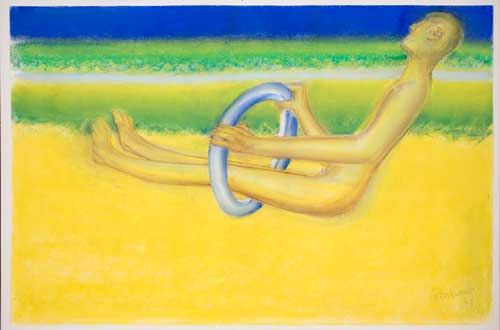The last work in the chronological installation at Richard Artschwager‘s 2012 retrospective at the Whitney Museum was a large pastel on paper drawing representing the figure of a man, simplified and streamlined, something like a crash test dummy, his legs half through a pneumatic blue steering wheel that his hands rest upon though with a firm grip, as he drives alongside a blue band of sky, a green band of landscape along a brilliant yellow road. There is no car, just a steering wheel and the figure “in the driver’s seat” moving forward along an empty but glorious colored road, his body ageless yet his feet gnarled by age, his head tilted pensively, slightly away from us, the viewers, and toward the view, empty but glorious and endless.

Richard Artschwager, In the Driver’s Seat, 2008. Pastel on paper, 25 x 38 inches. Courtesy of David Nolan Gallery, New York.
I have often thought of this work since I saw it last fall. One evening I was thinking about my own life and particularly of how I wished that I could slow down enough to be able to invest greater time and kindness in other people because that is such a richly important part of one’s life but in the same instant visualizing myself as hurtling through my life like an early astronaut with little control of my spacecraft, just launched out into an unknown but speeding trajectory of my work as an artist. I thought of the Artschwager piece, In the Driver’s Seat, which I felt profoundly addressed that image I felt so viscerally of the forward motion of a life hurtling toward the unknown. Yet it radiated a supreme calm and a joy that altered the darker side of my own vision.
I learned just now that Richard Artschwager died today, at the age of 89. He was a unique and a great American artist, whose work was marked throughout by a calm, philosophical and deliberative quality, sharp intelligence, utter formal clarity, and a cool, sometimes even remote yet mischievous nature.
I first saw his work in a Whitney Biennial in the mid 1970s, only I didn’t know who had made the objects I noticed–in fact I wasn’t totally sure the strange objects were artworks in the exhibition–strange steel wool like oblong discrete objects placed in unusual locations, inside the building, but not exactly where an art work might be located–near a fire alarm, above an exit door, and, as I recall, outside the building as well. A couple of years later he visited the Nova Scotia College of Art & Design where I then taught and thus I discovered the identity of the artist who had created those strange “blps,” and I had the opportunity to get to spend some time with him.
I was just talking about his lecture this past week, thinking of the way that artists spoke in the ’70s: at worst, you got male artists presenting one work after another in a monotonous “and then I did this and then I did this” stream of aggressive and oppressive non-revelation, or, on the more positive side, an artist would visit who spoke as he or she wished (though in those days still most often a he), from whatever starting point, and at whatever length was necessary to get across the thoughts in their work: and the talks were about works but those good talks were always about thoughts, ideas, desires for art, not about exhibitions or market. Artschwager’s was such a talk, marked by a particular characteristic that had some in the audience puzzled–he would stop and you could see his mind working through something, and when he began to speak again, he was at the next point, having left out that step. You had to keep up with him, get used to the way his mind worked, and that deliberative, thorough, yet elliptical method was a perfect equivalent for the way that his works appeared to address space and the viewer.
Last year, I wrote about his work, some of it also late work in a similar vein to In the Driver’s Seat, in a beautiful exhibition at David Nolan Gallery, in the blog post, Youthfulness in Old Age. Please take a look and I will expand on this post at a later date.
His gallery has just posted a notice with a marvelous picture:

Richard Artschwager, Photo: Rachel Chandler, Courtesy David Nolan Gallery
An interview with Richard Artschwager by John Yau and Eve Ascheim from 2008 can be read here.
